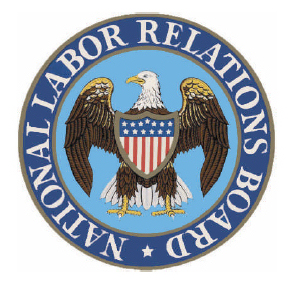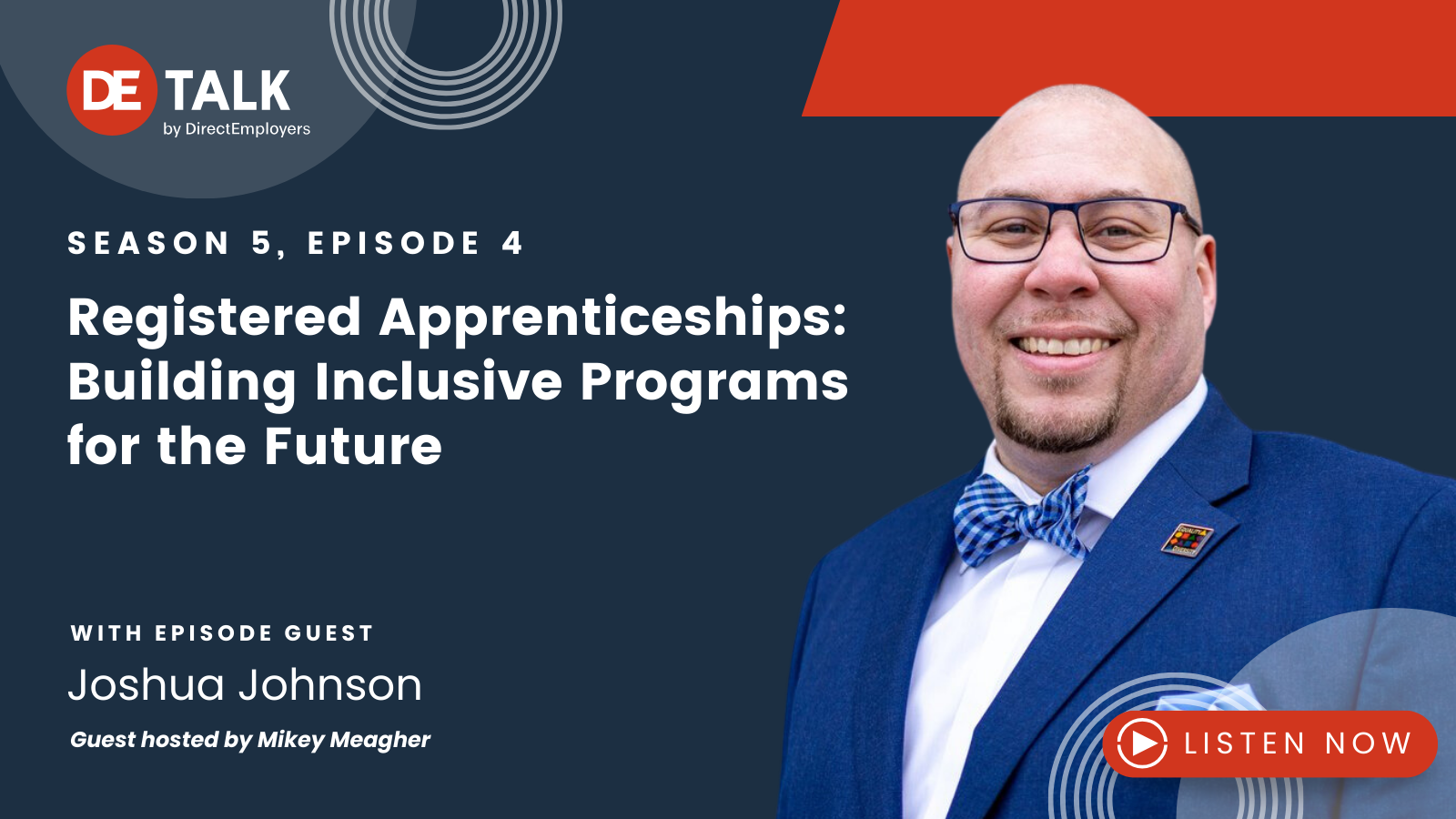
- DE Talk Podcast Discussed Registered Apprenticeships
- Touting Systemic Enforcement Efforts, US EEOC Issued Its FY 2023 Agency Financial Report
- President Biden Signed Two-Tiered Continuing Resolution Appropriations Bill Funding Federal Government Through Early Next Year
- US NLRB Extended Effective Date of Joint-Employer Rule to February 26, 2024
- In Brief
- Looking Ahead: Upcoming Date Reminders
Tuesday, November 14, 2023: DE Talk Podcast Discussed Registered Apprenticeships
In celebration of National Apprenticeship Week, we have a special episode of DE Talk! The reality of today’s labor marketing indicates that there aren’t enough college graduates and experienced workers to meet market demands. Apprenticeships are working to steady the gap by incorporating hands-on learning with education and life experience. Tune in as Joshua Johnson from Jobs for the Future (JFF) shares the seven components of Registered Apprenticeships, how to engage with your state apprenticeship system, what apprenticable occupations look like in fields that would surprise you, and the benefit this type of employment offers for employers and apprentices.
Listen to our DE Talk Podcasts via any of the options below and subscribe to receive updates whenever a new podcast is available.
Apple • Spotify • Google • Stitcher • iHeartRadio • Stitcher • TuneIn • Overcast • Pocket Casts • Castro • Castbox • Podchaser • RSS Feed
…or your preferred Podcast provider!
Wednesday, November 15, 2023: Touting Systemic Enforcement Efforts, US EEOC Issued Its FY 2023 Agency Financial Report
Report Long on Narratives, But Short on Statistics
Agency Plans to Release Comprehensive Enforcement & Litigation Stats Early Next Year

The Management Discussion and Analysis (“MD&A”) section of the AFR (pages 7-37) provided an overview of the EEOC’s performance and financial information. Of particular note, the “Performance Results” section (pages 18-32) was long on narratives of specific cases and outreach efforts but short on overall statistics. Nevertheless, it included information on:
- Systemic discrimination (pages 18-19): In FY 2023, the EEOC filed 25 lawsuits challenging systemic discrimination, comprising 17.5 percent of all merits suits filed. Of these 25 systemic cases, 11 were “pattern or practice” cases. The FY 2023 systemic filings were the largest number of systemic filings since 2018. The allegations in these systemic lawsuits included hiring claims based on sex, race, national origin, age, and disability; harassment claims based on sex and race; claims of failure to accommodate and unlawful application of a qualification standard based on disability; discharge claims based on disability, race, color, and retaliation; and an equal pay claim based on sex. The agency also resolved 14 systemic lawsuits;
- Workplace Harassment (pages 20-21): During FY 2023, the EEOC resolved 35 lawsuits alleging harassment (all bases);
- Racial Discrimination (pages 22-24): “Over the past six fiscal years, approximately one-third of all charges filed with the EEOC have alleged some form of racial discrimination,” the AFR reported. In FY 2023, the EEOC resolved 19 lawsuits alleging race and/or national origin discrimination;
- Retaliation (pages 25-26): In FY 2023, the EEOC resolved 34 lawsuits alleging retaliation;
- Pay Equity (pages 26-27): During FY 2023, the EEOC resolved nine lawsuits involving compensation discrimination, including one systemic case;
- Advancing Workplace Diversity, Equity, Inclusion, and Accessibility (pages 27-29): This section contains a discussion of the EEOC’s outreach efforts and work with other agencies, including OFCCP; and
- Addressing the Use of Technology, Including Artificial Intelligence, Machine Learning, and Other Automated Systems in Employment Decisions (pages 29-31): In FY 2023, the EEOC “resolved two matters with technology at the forefront.” This section discusses the agency’s September 2023 settlement with iTutorGroup (see our story here) and its March 2023 settlement with DHI Group Inc., a job-search website operator posting corporate job vacancies for technology professionals on its Dice.com website (see our story here). As we explained in both of our stories on these settlements, neither one constituted a case involving actual Artificial Intelligence tools, but rather these cases involved the use of computer code to ferret out certain groups of job seekers.
The EEOC’s announcement also noted that the AFR reflects that, “for the 19th consecutive year, the agency received an unmodified opinion from independent auditors, reflecting the EEOC’s sound financial management and internal controls.”
Thursday, November 16, 2023: President Biden Signed Two-Tiered Continuing Resolution Appropriations Bill Funding Federal Government Through Early Next Year
US DOL Budget Will Remain at Present Level Through February 2, 2024

Our story on the FY 2023 appropriations law is here. See our story on the U.S. Department of Labor’s (“DOL”) FY 2024 budget proposal here. For a deep dive into OFCCP’s FY 2024 budget request, see our story here.
The law signed on Thursday puts the federal agency funding into two batches. The first batch funds the Departments of Transportation, Housing and Urban Development, Energy, Veterans Affairs, and Agriculture at current levels through January 19, 2024. The second batch funds the rest of the government – including the DOL, the Equal Employment Opportunity Commission, and the National Labor Relations Board – at current levels through February 2, 2024. Since Congress placed the DOL budget in the last batch to terminate, that indicates Congress considered it one of the more difficult budgets to fund. Thus, Congress put it in the “needs-more-time-to-bake” batch, beyond those budgets terminating earlier (on January 19).
What Does It Mean for OFCCP?
OFCCP’s 34-page FY 2024 Budget Justification reports on page 7 that its revised enacted FY 2023 Budget is at $110,796 million and 495 full-time equivalent employees (“FTEs”) and that it is seeking a whopping 36 percent increase in budget (to $151,462 million) and 125 additional FTEs (+25 percent).
Moreover, page 11 of the FY 2024 Budget Justification reports that OFCCP will have to spend in FY 2024 $2,769,030 for compensation increases for its 495 FTE headcount (which does not include the additional compensation costs for the additional 125 FTEs OFCCP seeks to hire in FY 2024). Consequently, by February 2, 2024 (4/12ths of its FY 2024), the agency will have lost one-third of the $2,769,030 it has to pay for pay increases but has no additional budget to pay. That equals about $913,780, or a loss, in effect, of four FTEs because OFCCP will “find” that money in its budget through budget “savings” by not hiring four employees for vacant positions – which each cost about $217,000 these days.
Thursday, November 16, 2023: US NLRB Extended Effective Date of Joint-Employer Rule to February 26, 2024
GAO Report Found Previous Implementation Date Violated Congressional Review Act

The Board stated that it will publish a formal Notice of the extension in the Federal Register “shortly.” As of our WIR deadline, the Federal Register website has not indicated a publication date for this promised Notice.
Previous Implementation Date Violated the Congressional Review Act
According to the NLRB statement, the reason for the implementation delay is “to facilitate resolution of legal challenges with respect to the rule.” However, the Board failed to mention that on November 9, 2023, the U.S. Government Accountability Office (“GAO”) issued a Decision concluding that the original December 26, 2023, implementation date violated the Congressional Review Act (“CRA”). The GAO addressed this decision to the Chairs and Ranking Members of the Senate Health, Education, Labor, and Pensions (“HELP”) Committee and the House Education and the Workforce Committee.
Specifically, the GAO said that “[the CRA] requires a 60-day delay in the effective date of a major rule from the date of publication in the Federal Register or receipt of the rule by Congress, whichever is later.” (See 5 U.S.C. § 801(a)(3)(A). The Final Rule was published in the Federal Register on October 27, 2023. As we noted in our story last month detailing the Final Rule, the White House Office of Management and Budget classified this Final Rule as a major rule subject to Congressional review. The House of Representatives received the rule on October 27, 2023, and the Senate received the rule on October 30, 2023, the GAO noted. The previous December 26, 2023, effective date did not have the required 60-day delay, the GAO pointed out. Consequently, the previous December 26 implementation date did not comply with the required 60-day delay, the GAO decided.
Furthermore, the GAO decision stated that “[i]n its submission to us, the [NLRB] indicated that it did not prepare an analysis of costs and benefits for this final rule.”
Legislators Introduced Promised CRA Resolution to Overturn Final Rule
Also on November 16, Senator Bill Cassidy (R-LA), Ranking Member of the Senate HELP Committee, issued a statement noting the GAO decision. He also said that he, along with other legislators, introduced, on November 9, a CRA Resolution – S.J.Res.49 – to overturn the Final Rule. We noted in our story last month, that Senator Cassidy, along with Joe Manchin (D-WV), had on October 26, announced their plan to introduce this CRA Resolution.
In Brief
Thursday, November 9, 2023: U.S. Office of Personnel Management Released Memo to Guide Federal Agencies in Supporting Military/Vet Spouses

Director Ahuja also noted that Section 2(a) of the EO directs the OPM, along with the Office of Management and Budget, and in consultation with the Departments of State, Defense, Labor, Veterans Affairs, and Homeland Security, to develop and issue a government-wide “Military-Connected Strategic Plan.” He reported that “[t]his strategic plan is forthcoming later this year and will be shared with all agencies.”
See also, our story: Thursday, September 28, 2023: U.S. Office of Personnel Management Expanded Access to Federal Jobs for Military Spouses.
Looking Ahead:
Upcoming Date Reminders
There are two NEW items added to our calendar this week:
June 2023: U.S. DOL WHD’s current target date (now overdue) to publish its Final Rule on Nondisplacement of Qualified Workers Under Service Contracts (RIN: 1235-AA42)
June 2023: U.S. OSHA’s current target date (now overdue) to publish its Final Rule on Occupational Exposure to COVID-19 in Healthcare Settings (RIN: 1218-AD36)
August 2023: U.S. DOL WHD’s (now overdue) target date for its Final Rule on Employee or Independent Contractor Classification Under the Fair Labor Standards Act (RIN: 1235-AA43)
August 2023: U.S. NLRB’s (now overdue) target date for its Final Election Protection Rule (RIN: 3142-AA22)
August 2023: U.S. DOL’s OASAM’s (now overdue) target date to publish Proposed Rule on “Revision of the Regulations Implementing Section 188 of the Workforce Innovation and Opportunity Act (WIOA) to Clarify Nondiscrimination and Equal Opportunity Requirements and Obligations Related to Sex” (RIN: 1291-AA44)
November 20, 2023: Deadline for comments on the Census Bureau’s Proposal to Test Questions on Sexual Orientation & Gender Identity for the American Community Survey
November 27, 2023: Comments due on the U.S. Office of Personnel Management’s Interim Final Rule to extend the eligibility date for noncompetitive appointment of military spouses married to a member of the armed forces on active duty through December 31, 2028
December 5, 2023: Submission deadline for EEO-1 Survey Component 1 Data Collection (collection period opened on October 31, 2023)
December 5, 2023: Comments due on the White House Office of Management and Budget’s proposed guidance to federal agencies on how they should implement Biden’s Executive Order on Artificial Intelligence
December 26, 2023: NLRB’s Direct Final Rule revising its procedures governing representation elections takes effect
December 29, 2023: Statutory deadline for EEOC to finalize regulations to enforce the Pregnant Workers Fairness Act
December 2023: OFCCP’s current target date for its Notice of Proposed Rulemaking to “Modernize” Supply & Service Contractor Regulations (RIN: 1250-AA13)
December 2023: OFCCP’s current target date for its Final Rule on “Technical Amendments” to Update Jurisdictional Thresholds & Remove Gender Assumptive Pronouns (RIN: 1250-AA16)
January 1, 2024: U.S. DOL OSHA’s Final Rule Requiring Covered High-Hazard Industry Employers to Electronically Submit Injury & Illness Records takes effect
NEW February 26, 2024: Effective date of NLRB’s Final Rule on Standard for Determining Joint-Employer Status under the NLRA (previous December 26, 2023, effective date extended)
April 3 – April 5, 2024: DEAMcon24 New Orleans – NEW The DEAMcon24 Program is now live!
January 1, 2024: The minimum wage for federal contracts covered by Executive Order 13658 (“Establishing a Minimum Wage for Contractors”) (contracts entered into, renewed, or extended prior to January 30, 2022), will increase to $12.90 per hour, and the minimum cash wage for tipped employees increases to $9.05 per hour (See our story here detailing exceptions)
January 1, 2024: The minimum wage for federal contractors covered by Executive Order 14026 (“Increasing the Minimum Wage for Federal Contractors”) (contracts entered into on or after January 30, 2022, or that are renewed or extended on or after January 30, 2022), will increase to $17.20 per hour, and this minimum wage rate will apply to non-tipped and tipped employees alike (See our story here detailing exceptions)
June 2024: OFCCP’s current target date for its Notice of Proposed Rulemaking to Require Reporting of Subcontractors (RIN: 1250-AA15)
THIS COLUMN IS MEANT TO ASSIST IN A GENERAL UNDERSTANDING OF THE CURRENT LAW AND PRACTICE RELATING TO OFCCP. IT IS NOT TO BE REGARDED AS LEGAL ADVICE. COMPANIES OR INDIVIDUALS WITH PARTICULAR QUESTIONS SHOULD SEEK ADVICE OF COUNSEL.
SUBSCRIBE.
Subscribe to receive alerts, news and updates on all things related to OFCCP compliance as it applies to federal contractors.
OFCCP Compliance Text Alerts
Get OFCCP compliance alerts on your cell phone. Text the word compliance to 18668693326 and confirm your subscription. Provider message and data rates may apply.


